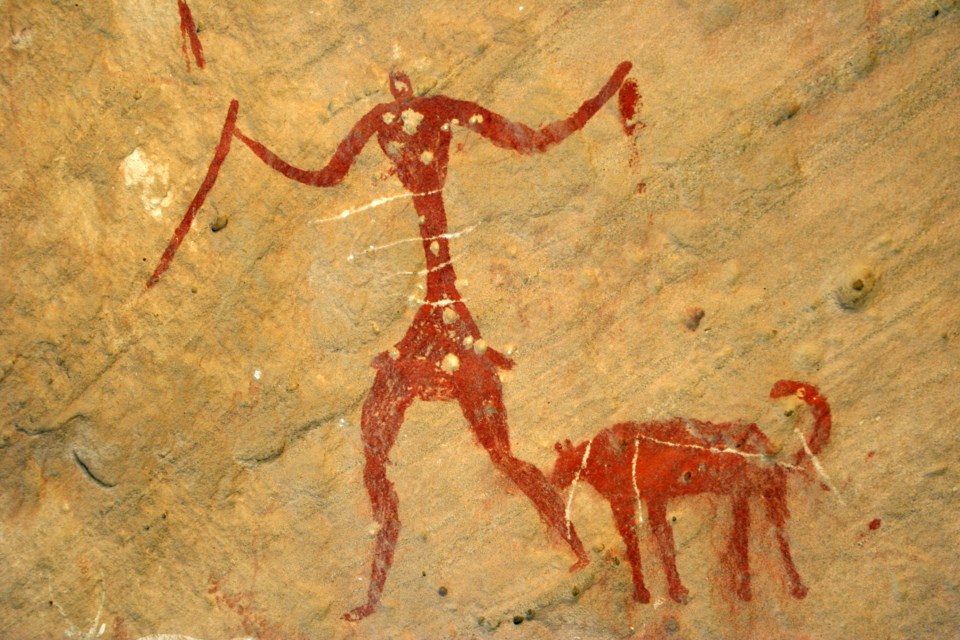About 30,000 years ago, humans contrived to bring an object into their lives that acts like a “reverse mop,” sponging up mud, dirt, leaves, spores, animal poop and all manner of natural bricolage from the great outdoors and transporting it directly into their dwellings to be wrung out. During the process, this highly efficient tangle of fibres also sheds multitudinous bits of itself which, along with the aforementioned debris, is distributed in record time to all surfaces, nooks and crannies. We call this marvel of unwitting environmental engineering a dog.
As anyone who cohabits with one knows, a range of positive attributes and noble qualities allow us to magically overlook the dog’s basic function as a subsonic agent of entropy.
When North Americans weaned on Rockwellian idyll bring a new dog home, they can’t help but nurture tableaux of all the iconic things they’ll do with said animal. Of course, the dog has other ideas, or, less anthropocentrically put, the “ideas” instinct delivers to the business of doginess. Thus, you can’t expect it will find all or even any of the conceptual vignettes you expend considerable energy on appealing. The dog presages this imminent demonstration of decision-making by immediately putting you on its poo-pee-play-walk-anxiety schedule. Though this may seem benign, it’s actually insidious. Thought you were beholden to family, work or your own hedonistic pursuits? Perhaps once upon a time. But falling in thrall with this craftiest of inventions, you’re captured in a way that makes previous captures in your life appear like casual flirtations. You are now living in a dog’s world.
As you joyously shout “We got a dog!” to all and sundry, the animal silently basks in its own considerably more impressive acquisitions: a cadre of fawning servants catering to its every whim including cleaning up vomit and feces; an extended group of human friends only too happy to likewise indulge; food forever (and what food!); warmth, bedding and an endless wake of interesting discards; their own frickin’ car with chauffer and ownership of an entire house for gawdsake.
The 21st century has turned the original intent of “It’s a dog’s life” on its head.
I had dogs most of my childhood, yet didn’t feel the same servitude (though perhaps my parents did). As an adult, I spent 14 years as activity and social coordinator to an über-intelligent husky-border collie cross called Mosquito (there’s a long story behind the name) who became a nationally known, much-loved frisbee dog. Since his passing in 1995, however, I’ve remained dogless due to work-dictated travel. When my partner and I recently began contemplating dog adoption from WAG (amazing folks doing amazing work while severely understaffed and underfunded—please donate and/or push for more funding where and when you can) we were looking at a slow process.
As that accelerated into a now-or-never scenario, we pulled the trigger with little idea of the swiftness of impending change. Pockets of multiple garments now hemorrhage dog-poo bags, treats and remnants of things no human would ever imagine consuming. Ditto the car, an instant four-star disaster decorated with a potpourri of autumnal leftovers and snow-removal detritus; in the vehicle’s eight-year life, five cross-Canada trips, megatons of transported burdock and smears of everything from snake-shit to chocolate could not accomplish what an hour of intermittent backseat riding by a dog managed.
Previously, I used a vacuum cleaner once a month. Now, with dog hair (a marvel of electrostaticity) on my stove and computer screen? Every. Single. Day. The house smells alternately of wet, saliva-soaked fur and microwaved hotdogs. (Don’t worry, if you’re coming over we’ll air it out first). The cost of pet food and veterinarians? HFS.
And there’s even more impact than you actually see. As one friend remarked when I mentioned the new addition, “A dog? Dogs aren’t green, buddy.”
He had a point. I have a sustainability reputation to uphold and, next to having a baby, a dog is the easiest way to increase your carbon footprint by orders of magnitude overnight. Buy all the sustainably made 100-mile food and local treats you want, but you’re still the final stop on a largely untraceable carbon trail for reams of small plastic bags, pouches and cans of who-knows-what. Then there’s dog dishes, brushes, toys, bed, leashes, collar, harness etc. etc. Even if some of these involve recycling, upcycling or repurposing, you’re facing down a carbon bomb that makes a flight to Maui seem like a donation to the Suzuki Foundation.
As someone in charge of a non-human life, you find out more about things you were already questioning. Like one of myriad reasons the Resort Municipality of Whistler needs to ban all fireworks, and why off-leash dogs you already thought were a problem for walkers and cyclists are even more so for law-abiding owners trying to train new pets—particularly rescue animals with special needs. Consider, for instance, where one might go in Creekside (or anywhere in Whistler for that matter) to not encounter off-leash dogs. Nowhere! Which means you need to get in the car (carbon bomb again) to seek the least-likely places at the least-likely times of day.
Of course, this litany is all in good fun, meant to highlight why it’s actually awesome to have a dog again. Positives—like getting more exercise than you’ve ever thought possible. And so much love, as nothing can melt the human heart like a wagging tail, questioning eyes or a gentle paw on the arm. As it turns out, our 30,000-year-old ancestors were onto something when they embarked upon the one adage that will never change: dogs truly are humans’ best friends.
Leslie Anthony is a Whistler-based author, editor, biologist and bon vivant who has never met a mountain he didn’t like.




